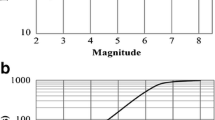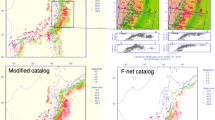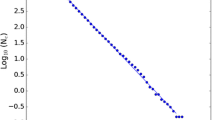Abstract
The longitude, latitude and depth of the hypocenter in 3-D space and the date and time of rupture makes an earthquake a “point” in a spatio-temporal point pattern, observed over a region and months, years or decades. The magnitude of earthquakes marks the point pattern, as would hypocenter depth do if only the longitude and latitude of epicenters were used for location in 2-D space. Stochastic declustering, based on a space–time ETAS model (ETAS: epidemic-type aftershock sequence), is a procedure that can be applied in the preliminary stage of an earthquake catalog data analysis. Stochastic declustering procedures have underlying assumptions, such as the time independence of the background intensity function whether the spatial framework is 2-D or 3-D, and a separate treatment of hypocenter depth from longitude and latitude when the spatial framework is 3-D. Cyclical processes in the Earth, including tides and seasonal surface water loads, can introduce periodic behavior in earthquake occurrence and related variables. The effects of ETAS-based 2-D and 3-D declustering on the outcome of periodicity analyses performed from the resulting earthquake data catalogs are studied. The research objectives and statistical challenges include the detection of periodicities for hypocenter depth in addition to monthly earthquake number, and the risk of missing observations for hypocenter depth when the monthly earthquake number after declustering is zero. A version of the method of multi-frequential periodogram analysis (MFPA) that allows for missing observations in the input temporal series is presented in detail, and applied to hypocenter depth (monthly mean and median) for central and northern California from January 2006 to December 2014. The results obtained for the 2-D and 3-D declustered catalogs are compared with those for the original catalog for this region. A semiannual periodicity in hypocenter depth is detected for the original and 2-D declustered catalogs, and fitted with the goal of relating it to periodicities found in the time series of monthly earthquake numbers. Using these results for central and northern California earthquakes, some of the assumptions on the intensity function of the spatio-temporal point process in stochastic declustering are discussed and future research perspectives are proposed.



Similar content being viewed by others
References
Ader TJ, Avouac JP (2013) Detecting periodicities and declustering in earthquake catalogs using the Schuster spectrum, application to Himalayan seismicity. Earth Planet Sci Lett 377:97–105
Amos CB, Audet P, Hammond WC, Bürgmann R, Johanson IA, Blewitt G (2014) Contemporary uplift and seismicity in central California driven by groundwater depletion. Nature 509:483–486
Bonferroni CE (1936) Teoria statistica delle classi e calcolo delle probabilità, Pubblicazioni del R Istituto Superiore di Scienze Economiche e Commerciali di Firenze. 8:1–62
Brillinger DR (1994) Time series, point processes, and hybrids. Can J Stat 22:177–206
Brillinger DR (2014) Statistics of earthquakes. Statistics Reference Online, Wiley StatsRef, p. 6
Christiansen LB, Hurwitz S, Ingebritsen SE (2007) Annual modulation of seismicity along the San Andreas Fault near Parkfield. CA Geophys Res Lett 34:L04306
Daley DJ, Vere-Jones D (2003) An introduction to the theory of point processes. Volume I: elementary theory and methods. Springer, New York
Daley DJ, Vere-Jones D (2008) An introduction to the theory of point processes. Volume II: general theory and structure. Springer, New York
Dutilleul P (1990) Apport en analyse spectrale d’un périodogramme modifié et modélisation des séries chronologiques avec répétitions en vue de leur comparaison en fréquence. DSc. (Mathematics) dissertation, Université catholique de Louvain, Louvain-la-Neuve, Belgium
Dutilleul P (1995) Rhythms and autocorrelation analysis. Biol Rhythm Res 26:173–193
Dutilleul P (2001) Multi-frequential periodogram analysis and the detection of periodic components in time series. Commun Stat Theor Methods 30:1063–1098
Dutilleul P (2011) Spatio-temporal heterogeneity: concepts and analyses. Cambridge University Press, Cambridge
Dutilleul P, Cumming BF, Lontoc-Roy M (2012) Autocorrelogram and periodogram analyses of paleolimnological temporal series from lakes in central and western North America to assess shifts in drought conditions. In: Birks HJB, Juggins S, Lotter A, Smol JP (eds) Tracking environmental change using lake sediments: data handling and numerical techniques. Springer, Dordrecht, pp 523–548
Dutilleul P, Johnson CW, Bürgmann R, Wan Y, Shen ZK (2015) Multi-frequential periodogram analysis of earthquake occurrence: an alternative approach to the Schuster spectrum, with two examples in central California. J Geophys Res Solid Earth 120:8494–8515
Guo Y, Zhuang J, Zhou S (2015) A hypocentral version of the space-time ETAS model. Geophys J Int 203:366–372
Johnson CW, Fu Y, Bürgmann R (2017a) Seasonal water storage, stress modulation, and California seismicity. Science 356(6343):1161–1164
Johnson CW, Fu Y, Bürgmann R (2017b) Stress models of the annual hydrospheric, atmospheric, thermal, and tidal loading cycles on California faults: perturbation of background stress and changes in seismicity. J Geophys Res Solid Earth 122:10605–10625
Kagan YY (2014) Earthquakes: models, statistics, testable forecasts. American Geophysical Union/Wiley, Oxford
Ogata Y (1981) On Lewis’ simulation method for point processes. IEEE Trans Inform Theory 27:23–31
Ogata Y (1983) Likelihood analysis of point processes and its application to seismological data. Bull Int Stat Inst 50:943–961
Ogata Y (1988) Statistical models for earthquake occurrences and residual analysis for point processes. J Am Stat Assoc 83:9–27
Ogata Y (1992) Detection of precursory relative quiescence before great earthquakes through a statistical model. J Geophys Res 97:19845–19871
Ogata Y (1998) Space-time point-process models for earthquake occurrences. Ann Inst Stat Math 50:379–402
Ogata Y (1999) Seismicity analyses through point-process modelling: a review. In: Wyss M, Shimazaki K, Ito A (eds) Seismicity patterns, their statistical significance and physical meaning. Birkhauser-Verlag, Basel, pp 471–507
Ogata Y, Akaike H (1982) On linear intensity models for mixed doubly stochastic Poisson and self-exciting point processes. J R Stat Soc B 44:102–107
Ogata Y, Katsura K (1986) Point-process models with linearly parametrized intensity for application to earthquake data. J Appl Prob 23A:291–310
Priestley MB (1981) Spectral analysis and time series. Academic Press, London
Reasenberg P (1985) Second-order moment of central California seismicity, 1969–82. J Geophys Res 90:5479–5495
Schuster A (1897) On lunar and solar periodicities of earthquakes. Proc R Soc London 61:455–465
Schuster A (1898) On the investigation of hidden periodicities with application to a supposed 26-day period in meteorological phenomena. Terr Magn 3:13–41
Shelly DR, Beroza GC, Ide S (2007) Complex evolution of transient slip derived from precise tremor locations in western Shikoku. Jpn Geochem Geophys Geosyst 8:Q10014
Shumway RH, Stoffer DS (2011) Time series analysis and its applications. Springer, New York
Vere-Jones D (1970) Stochastic models for earthquake occurrence (with discussion). J R Stat Soc B 32:1–62
Vere-Jones D (1992) Statistical methods for the description and display of earthquake catalogues. In: Walden A, Guttorp P (eds) Statistics in the environmental and earth sciences. Edward Arnold, London, pp 220–236
Vere-Jones D, Ben-Zion Y, Zuniga FR (2005) Statistical seismology. Pure Appl Geophys 162:1023–1396
Wyss M (1991) Increased mean depth of earthquakes at Parkfield. Geophys Res Lett 18:617–620
Zaliapin I, Ben-Zion Y (2020) Earthquake declustering using the nearest-neighbor approach in space-time-magnitude domain. J Geophys Res 125(4):e2018JB017120
Zhuang J, Ogata Y, Vere-Jones D (2002) Stochastic declustering of space-time earthquake occurrences. J Am Stat Assoc 97:369–382
Acknowledgements
The corresponding author gratefully acknowledges a Discovery Grant in Mathematics and Statistics from the Natural Sciences and Engineering Research Council of Canada (NSERC) and a Travel Award from the Institute of Statistical Mathematics (ISM) in Tachikawa (Japan) on the occasion of the ISM Symposium on Environmental Statistics 2019. Funding for this research project was also provided by the U.S. Geological Survey National Earthquake Hazards Reduction Program (G15AP00106), the Southern California Earthquake Center (Award #15005), and the NASA Earth Surface and Interior (NNX17AE01G) program. The authors are not aware of any funding or financial holdings that may be perceived as a conflict of interest. Seismic data products for this study were accessed through the Northern California Earthquake Data Center (NCEDC), https://doi.org/10.7932/NCEDC. The Authors are grateful to the Editors and the Reviewers for their helpful and constructive comments on an earlier version of our manuscript.
Author information
Authors and Affiliations
Corresponding author
Additional information
Handling Editor: L. Duczmal.
Appendices
Appendix 1
1.1 Equations and statistical assumptions in the 2-D ETAS-based declustering procedure
In Zhuang et al. (2002), the conditional intensity function of the spatio-temporal point process proposed to model clustering in seismic activity, given the space–time magnitude occurrence history (\(\mathscr{H}_{t}\)) of the earthquakes up to time t, is written
where subscript a is used for an ancestor and \(\kappa (M_{a} )g(t{-}t_{a} )f(x{-}\xi_{a} ,y{-}\eta_{a} |{M^{*}}_{a} )j(M|{M^{*}}_{a} )\) represents the intensity function of the nonstationary Poisson process associated with the ath ancestor, under the following four “assumptions (a)–(d)”:
-
a.
The occurrence rate of background events is assumed to be a function µ(·) of spatial location of the epicenter and magnitude, but not of time.
-
b.
Each “ancestor” event produces “offspring” independently and the expected number of direct offspring from an individual ancestor is assumed to depend on its magnitude M and is denoted κ(M).
-
c.
The probability distribution of the amount of time separating the occurrence of an offspring event from its direct ancestor is a function of the time lag \(\Delta t\), and is independent of magnitude, so its density function has the form g(\(\Delta t\)). It is also independent of what happens between the two occurrence times.
-
d.
The probability distributions of the epicenter location (x, y) and magnitude M of an offspring event are dependent on the magnitude M* and the epicenter location (ξ, η) of its direct ancestor, so their density functions are written \(f\left( {x{-}\xi ,y{-}\eta |M^{*} } \right)\) and \(j\left( {M|M^{*} } \right)\), respectively.
Under a threefold “assumption (e)” which specifies that the magnitude distribution of a background event is independent of its location, the magnitude distribution of a direct offspring event is independent of the size of its ancestor, and the magnitude distributions for the background events and their offspring are identical (Zhuang et al. 2002), it follows the decomposition
where \(\lambda (t,x,y|{\mathscr{H}}_{t} ) = \mu \left( {x,y} \right) + \sum\nolimits_{{\{ a,t_{a} < t\} }} {\kappa (M_{a} )g(t{-}t_{a} )f(x{-}\xi_{a} ,y{-}\eta_{a} |{M^{*}}_{a} )} .\)
Appendix 2
2.1 Equations and statistical assumptions in the 3-D ETAS-based declustering procedure
The background seismicity rate (µ) is important in statistical models because it is related to tectonic loading. In the hypocentral extension of Guo et al. (2015), it continues to be assumed constant in time and variable in space, while the formulation for the cluster seismicity rate of an earthquake with magnitude M is similar to the second term on the right-hand side of (1) (Zhuang et al. 2002), with the same assumptions (a)–(d) but a main difference and further assumptions. The main difference is that in Guo et al. (2015), Zhuang et al.’s (2002) cluster seismicity rate is multiplied by a function h(z, zʹ), where z denotes the focal (hypocenter) depth of an aftershock (offspring event) and zʹ, the depth of the main shock (parent event). Further assumptions include: there is separability between depth and (longitude, latitude) and the corresponding features of the point-process model; the hypocenter depths (z, zʹ) follow a beta distribution with the shape parameter determined by the depth of the parent event, which provides suitable characteristics for the probability density function of depth in the formulation of Guo et al. (2015).
In the resulting 3-D ETAS model, the time-varying seismicity rate function is written
where za is the hypocenter depth of a parent event, and the cluster seismicity rate is
with the same functions κ(·), g(·) and f(·) as in (1) (Zhuang et al. 2002), and h(z, zʹ), the probability density function of the beta distribution used for the hypocenter depths (z, zʹ).
Appendix 3
3.1 MFPA variant for temporal series and MFP-derived coherency analysis: Matrix notations and basic elements
Consider a temporal series of length n > 2K + 1, arranged in a column vector y = \(\left( {Y_{{t_{1} }} , \ldots ,Y_{{t_{n} }} } \right)^{{\text{T}}}\) with T the transpose operator), and a vector \({{\varvec{\upomega}}} = \,\left( {\omega_{1} , \ldots ,\omega_{K} } \right)^{{\text{T}}}\) of K frequencies \(\omega_{{1}} \, < \, \ldots \, < \,\omega_{K}\), for which the MFPA statistic has to be calculated. Let X(\({{\varvec{\upomega}}}\)) denote the n × (2K + 1) matrix made of a first column of ones, followed by \(\cos \left( {\omega_{k} \cdot t_{i} } \right)\), i = 1, …, n and k = 1, …, K (even columns) and \(\sin \left( {\omega_{k} \cdot t_{i} } \right)\), i = 1, …, n and k = 1, …, K (next odd columns). With −1 the inverse operator, the univariate MFPA statistic IM(\({{\varvec{\upomega}}}\)) is written in matrix notation (Dutilleul 2001, 2011):
Let y1 and y2 be two time series or temporal series made of observations at the same n times, equally spaced or not. With \({I_{1}}^{M} ({{\varvec{\upomega}}})\) and \({I_{2}}^{M} ({{\varvec{\upomega}}})\), the two univariate multi-frequential periodograms, and \({I_{12}}^{M} ({{\varvec{\upomega}}})\, = \,{{\mathbf{y}}_{1}}^{{\text{T}}} {\mathbf{X}}({{\varvec{\upomega}}}) \, ({\mathbf{X}}({{\varvec{\upomega}}})^{{\text{T}}} {\mathbf{X}}({{\varvec{\upomega}}}))^{{{-}{1}}} {\mathbf{X}}({{\varvec{\upomega}}})^{{\text{T}}} {\mathbf{y}}_{{2}}\), the corresponding cross periodogram at frequencies \({{\varvec{\upomega}}}\) (based on a scalar product instead of a squared Euclidean norm), the MFP-derived coherency statistic is given by
and can be interpreted as a correlation coefficient (\(- \,{1}\, \le \, \cdots \le \,\, + \,{1}\)) in the frequency domain (Dutilleul 2001, 2011), for a vector of frequencies in the general case or a scalar frequency in the uni-frequential case, K = 1. The classical t-test for Pearson’s r sample correlation coefficient can be applied, with or without Bonferroni correction for the repetition of tests when the significance of more than one MFP-derived coherency statistic is assessed. The frequencies \(\omega_{k}\) (k = 1, … K) are not constrained to be Fourier frequencies, i.e., they do not have to correspond to an integer number of cycles over the series.
In closing, it must be noted that the vector of frequencies, \(\varvec{\upomega}\), is usually unknown in (5) and estimated in an iterative procedure in the univariate version of the MFPA, whereas it can be replaced with a known scalar, \(\omega\), set at the frequency corresponding to a periodicity of particular interest (e.g., 6 or 12 months) in (6) for the computation of the MFP-derived coherency statistic in the bivariate version.
Rights and permissions
About this article
Cite this article
Dutilleul, P., Johnson, C.W. & Bürgmann, R. Marked spatio-temporal point patterns, periodicity analysis and earthquakes: an analytical extension including hypocenter depth. Environ Ecol Stat 27, 689–708 (2020). https://doi.org/10.1007/s10651-020-00470-4
Received:
Revised:
Accepted:
Published:
Issue Date:
DOI: https://doi.org/10.1007/s10651-020-00470-4




